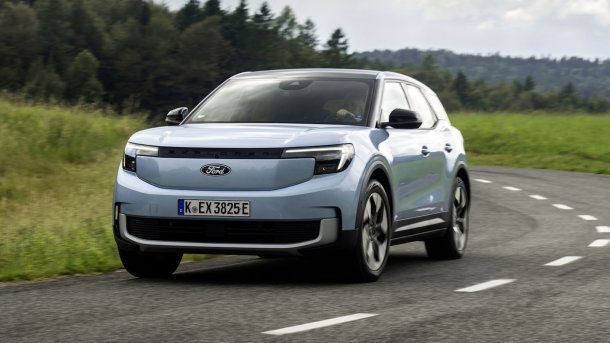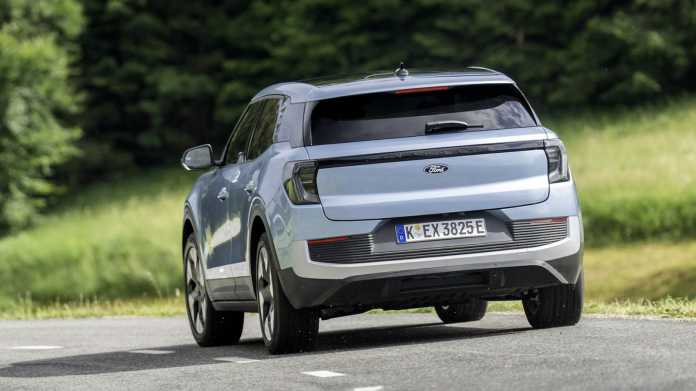Electric car: First driving impression of the Ford Explorer
For Ford in Europe, the Explorer is a new start into an electric future – with technology from Volkswagen. But the driving impression is quite different.

(Image: Ford)
- Joaquim Oliveira
Ford is relaunching almost its entire portfolio for the European market and retiring traditional models such as the Fiesta, Focus, Mondeo and Galaxy. With the Explorer, Ford is launching a battery-electric mid-range model that, like the ID models from VW, Skoda Enyaq or Audi Q4 e-tron, is based on the Volkswagen Group's MEB platform. This means that the Mustang Mach E, which was developed with a US focus, will be joined by an electric model designed for Europe. In addition to the two battery-electric cars, Ford also offers a partially electric option for its Puma (test) and Kuga crossover models. The Explorer is produced in Cologne. The conversion of production there to new electric models is said to be the main reason why it will be rolling out to customers this summer after a considerable delay. Ford wants to offer the 4.47 -meter car from 49,500 euros.
Entry-level model with 52 kWh from the end of 2024
At 77 and 79 kWh, the battery capacities are practically on a par with the VW models and there are no surprises in terms of performance either. While the rear-wheel drive version has an output of 210 kW and a torque of 585 Nm, the all-wheel drive version with an electric motor on the front axle has a combined output of 250 kW. The larger battery version can be charged with up to 185 kW, while the basic version achieves just 135 kW. An entry-level model with a 52 kWh battery and 125 kW from 42,500 euros will follow at the end of the year.
Ford Explorer (5 Bilder)

(Bild: Ford)
With 210 kW rear-wheel drive, the Explorer accelerates from standstill to 100 km/h in 6.4 seconds and reaches 180 km/h. The standard consumption of around 14 kWh per 100 kilometers should enable a range of 600 kilometers before it is plugged into the charger again. In reality, it is more likely to be around 480 kilometers and the all-wheel drive version only manages the 400 mark at best. With the additional 109 kW of power on the front axle, it is capable of reaching 5.3 seconds and a maximum of 189 km/h from a standstill.
Significantly more comfortable set-up
The first driving impression shows that the Explorer 4x4 delivers its power more confidently on the road, but is hardly more dynamic in everyday driving. On the other hand, the rear-wheel drive model has a turning circle that is one meter smaller, which is more noticeable in practical use than the small difference in driving dynamics. Unlike the technical basis, Ford does not install paddles for the recuperation intensity on the steering wheel. It can be preselected with driving mode B or via the sports program. However, true one-pedal driving is not possible in either case.
In contrast to the VW Group's electric models on the same platform, the Explorer is significantly more comfortably tuned. The braking feedback is direct and more linear than that of some higher-class electric cars. Unfortunately, the Cologne-based company has not fully transferred the excellent feedback of many Ford models to the Explorer. In all driving modes, the steering feels too light and imprecise. It is also a shame that Ford has dispensed with the adaptive dampers. They remain unaffected by the modes.
Ford Explorer (6 Bilder)

(Bild: Ford)
In the interior, the Explorer is reminiscent of a VW in some places. Switches, control modules and even the warning signals of the driver assistance systems are familiar from Škoda, VW or Audi. The small display unit behind the wheel is more than usefully supplemented by a head-up display. The central 14.6-inch infotainment screen makes a clear distinction. Another unique feature is the compartment between the two front seats, which offers a volume of 17 liters to accommodate laptops, several bottles or even medium-sized ladies' handbags.
450 liters of luggage space
Hard surfaces and unlined door pockets are not conducive to a high-quality impression. A central strip on the dashboard and doors has a slightly softer surface in the premium version. Even in the premium versions, however, Ford does not offer genuine leather. Nevertheless, the top version offers details such as a panoramic roof, Matrix LED headlights, a power tailgate and 20-inch alloy wheels.
With a wheelbase of 2.77 meters, the Ford Explorer also offers sufficient space for knees, head and shoulders in the rear. The rear seats can be folded down in a 1⁄3 to 2⁄3 ratio, whereby the middle seat can be lowered independently to remove an item from the 450 liter luggage compartment. There is space under the luggage compartment for the charging cable, for example, as Ford has dispensed with a frunk.
(olb)